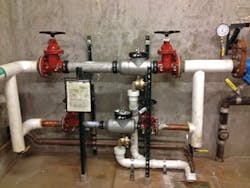Commercial Water: Triple Threat
About the author: Ezra Phillips is product manager for Zurn Industries LLC. Phillips can be reached at [email protected] or 855.663.9876.
When a convergence of plumbing problems at the Auraria Campus in downtown Denver reached the point of necessary replacement, the chosen solutions required another convergence: the unanimous votes of three separate colleges.
The 150-acre campus is shared by the Community College of Denver, Metropolitan State University of Denver and University of Colorado Denver, and serves a collective student population of approximately 42,000 and an additional 5,000 faculty and staff. Services and facilities management are handled by a separate state entity: the Auraria Higher Education Center. All three colleges share a deferred maintenance fund program for all projects and, therefore, all three institutions must agree on which projects to pursue.
In 2014, the colleges identified priorities that included the replacement of more than 100 backflow preventers for isolation, containment and irrigation systems, and tempering valves for separate facilities serving children and college athletes.
Updating Backflow Preventers
The backflow preventers in place were from a mixed pool of manufacturers, with many more than 20 years old. A large percentage of the devices had non-replaceable brass seats that continually failed annual testing.
“The existing backflow preventers on campus were becoming more and more irreparable,” said Tom Johnson, plumbing and steam systems supervisor for the campus.
With the new federal low-lead law as a catalyst for change, Johnson said the campus decided to install Zurn Wilkins 350XL and 375XL backflow preventers for their modularity, ease of service and lead law compliance.
“The Zurn Wilkins units were ideal because of the removable thermoplastic body and ease of installation,” said Ken Ross, campus engineer. “Having a blow-out fitting available for these units is huge for us and makes maintaining these units very easy.”
Johnson echoed that observation. “Having the ability to remove and replace the plastic body containing the checks, and the redundancy of the same device in multiple locations, [made] it a no-brainer to use Zurn throughout the campus,” Johnson said. “With the new lead-free law that went into effect, this project was a priority because backflow prevention is a safety issue.”
Updating Tempering Valves
Tempering valves were another safety issue for the Auraria Campus, which includes a large childcare facility and primarily utilizes steam for water heating. The steam heat exchangers can produce extremely high water temperatures in a matter of minutes. The potential failure of a tempering valve with a steam water heater was a major concern.
In addition, the campus is home to an NCAA Division II championship basketball team, along with a number of other collegiate teams that use the physical education building. This building includes showers and other equipment that rely on large volumes of tempered water protection.
For both faucet and shower bank needs, Zurn Wilkins 1070XL and 3870XL thermostatic mixing valves were utilized to temper the hot water systems to a safe temperature, avoiding the risk of burns or scalding. Work also was done on all sinks in buildings heated by natural gas and electricity.
“Safety and updating our childcare facilities to new codes and standards are personal to the members of the plumbing shop and management here,” Johnson said. “They are also vital to their accreditation.”
All plumbers in the shop are required to be certified testers and repairers, and Johnson said their input was heavily weighed by the plumbing supervisor before deciding which solutions to choose. The campus shop has four licensed plumbers—two of whom are masters—with a combined total of 101 years of trade experience.
Repairs & Downtime
According to Johnson, the campus buildings are now code compliant or better, and maintenance costs have gone down. “What’s really great is the equipment or building downtime [now] can be [only] a matter of minutes with a failed backflow device,” he said. “The plastic section can be removed and the new rebuilt checks can be dropped right in. The device can then be tested and the equipment or building is back in service within five to 10 minutes. This is critical, as we have three colleges on campus and around 95% of our square footage is filled daily. We don’t have time for lengthy repairs or looking for parts. We keep new check assemblies of all sizes for replacement, but we have not had any test failures out of all the new devices.”
Download: Here
